1.Asset Allocation Changes…Money Flowing to Large Cap and Emerging Markets.
SPDR BLOG

Asset allocation: Bullish on emerging markets, bearish on high yield
With respect to asset allocation trends, the chart below reveals where investors are willing to increase or decrease exposure as we head into the second half of 2019. Any asset class below the line indicates more bullish sentiment, where respondents are more inclined to increase allocations relative to the percentage seeking to decrease. Investment-grade credit has the highest ratio of increase to decrease percentages, reflecting the strongest agreement among respondents on where to position. This indicates investors’ preference to move up in quality this late in the cycle.
Emerging markets is a key area where investors are increasing allocations, with 40% of those surveyed indicating that they plan to do so. This is likely a result of the attractive valuations in the region combined with supportive demographic trends. However, we note that this survey was taken while trade tensions appeared to be softening. As recent rhetoric has reignited fears of a trade war escalation, the results of this survey might look somewhat different today.
On the bearish side, investors cited high yield bonds as an area where they plan to reduce allocations, with 30% planning a decrease. High yield not only had the highest decrease percentage, but also had the highest ratio of decrease to increase. As credit spreads continue to tighten—currently they’re 34% below the long-term 20-year median—high yield bonds present less upside relative to downside on a forward-looking basis,1 and may partially explain these survey results.
Consistent with our theme of ‘cautiously optimistic’ attitudes toward US equity markets, US large cap results were mixed. While investors are planning to increase their small-cap allocations, they are also expecting to increase allocations to cash. Lastly, while broad developed ex-US is on the bullish side of the ledger, specific country or region allocations to Europe or Japan are not. The latter reflects the unwillingness of investors to take on country- or region-specific risk, but rather be broadly diversified outside the US.
2.Bank of Japan Owns 80% of Japanese ETFs Outstanding.
The BoJ owns 43% of all Japanese government bonds and 80% of all ETFs outstanding, see chart below. Despite record high government debt levels and massive budget deficits we are still not seeing any signs of growth or inflation. The lesson from Japan is that it is not just a matter of spending more money we don’t have and thereby raising debt to GDP. If the goal is higher growth it is much more important to discuss how we design institutions and public policies the best way to maximize living standards for all parts of the income distribution at the lowest cost for the government. For the United States a good place to start this discussion is the OECD’s latest 2018 Going for Growth policy recommendations here.
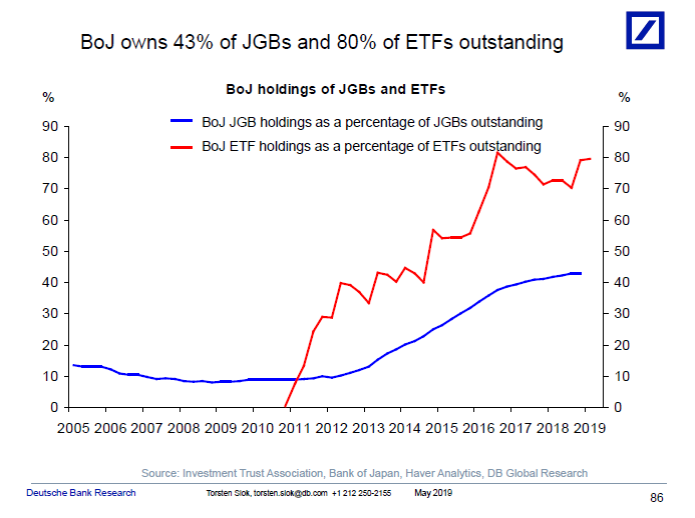
Let us know if you would like to add a colleague to this distribution list.
Torsten Sløk, Ph.D.
Chief Economist
Managing Director
3.Is U.S. Outperformance vs. China Primarily About Buybacks?
One component of return swamped all others in predicting returns: whether the total supply of shares was contracting or expanding. That alone, says Mr. L’Her, explains more than 80% of the extent to which returns have diverged across stock markets over the past 20 years.
When companies buy back their own stock (or when corporate mergers and acquisitions remove it from the market), then shares become more scarce. That makes the remaining shares more valuable. With corporate profits parceled out among fewer shares, future returns are likely to be higher.
By contrast, when companies—or governments, as in China—sell more stock to the public, then shares become more plentiful. As the market is flooded with stock, ownership in such diluted shares becomes less valuable. Corporate profits get spread across a bigger base of stocks, causing future returns per share to fall. And investors become less choosy, enabling lower-quality companies to issue shares and making losses more likely.
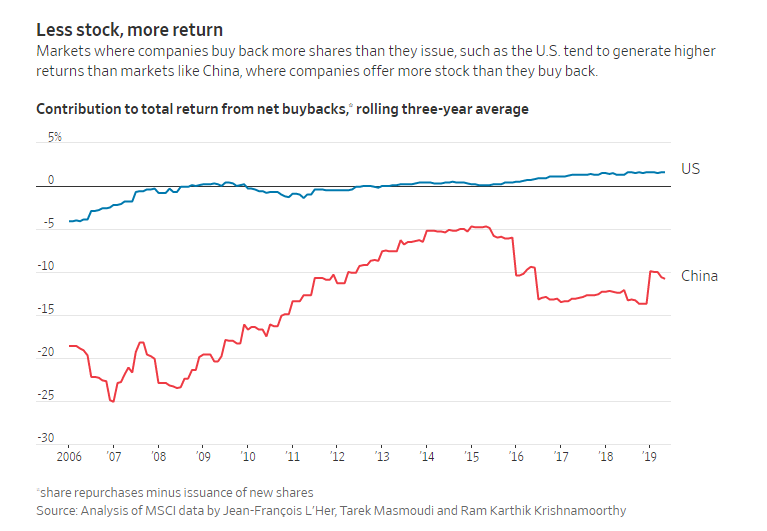
Think Before You Fish for Bargains in Chinese Stocks
Crazy but true: Countries with faster-growing economies often produce lower—not higher—stock-market returns
By
Jason Zweig
https://www.wsj.com/articles/think-before-you-fish-for-bargains-in-chinese-stocks-11558710015?mod=itp_wsj&ru=yahoo
4.It’s Not About GDP Growth….13 Straight Years Below 3% for U.S.
But the US also just hit a record 13 straight years without 3% real GDP growth
While the US has had a record period of economic expansion, it’s not setting the world on fire. It’s been a record 13 straight years without reaching 3% real gross domestic product growth.
The US has come close, hitting 2.9% growth in 2018, but America hasn’t hit a real GDP growth of 3% since 2005, when it grew 3.5%.
The previous record stretch? Four years to start the 1930s, a dark time in the US economy following the 1929 stock market crash. By 1934, real GDP growth was going gangbusters, growing 10.8% that year.
Source: Bureau of Economic Analysis
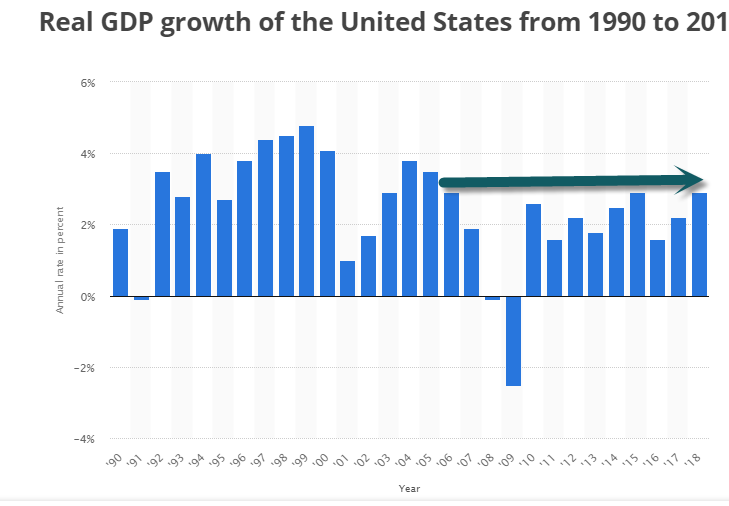
https://www.statista.com/statistics/188165/annual-gdp-growth-of-the-united-states-since-1990/
5.Information Technology -7% in May.
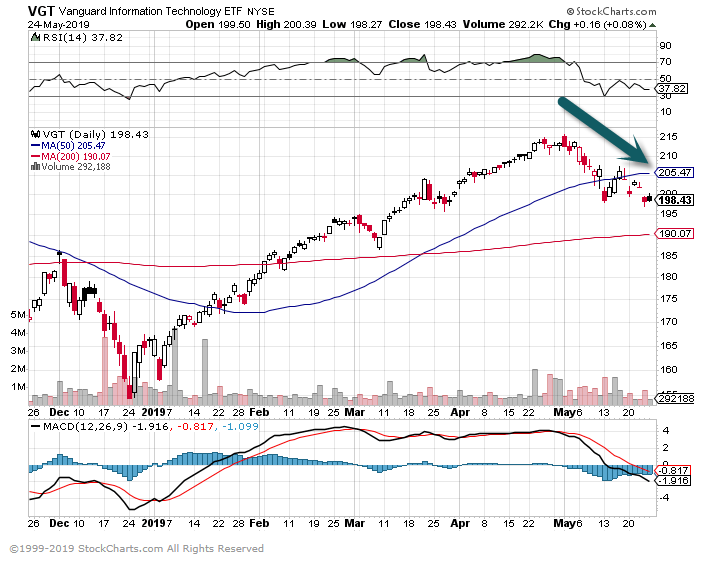
6.U.S. Manufacturing Activity Dropped to a 9 Year Low
The Markit PMI indices point to a sharp pullback in business activity this month in response to renewed US-China trade tensions. Both the manufacturing and the service-sector measures were well below consensus estimates.
Manufacturing:
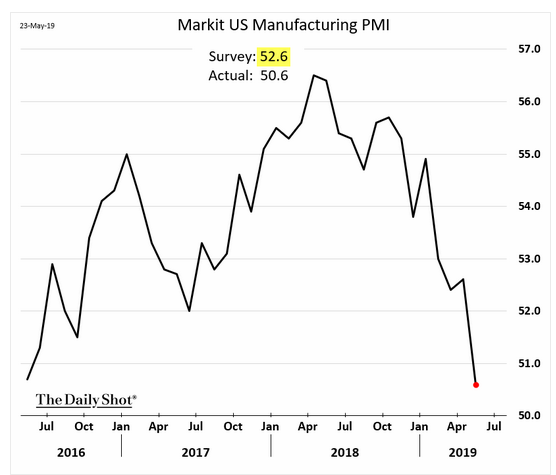
Source: CNBC; Read full article
The new orders index:
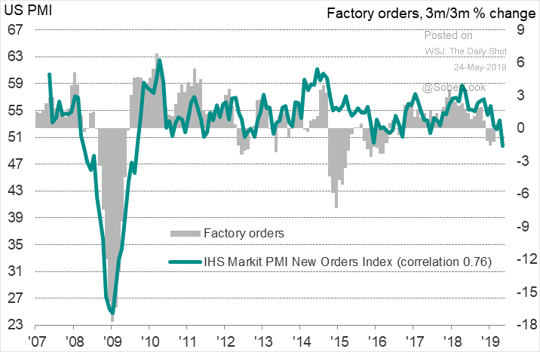
Source: @WilliamsonChris
7.Copper Miners Dropped -20% in 3 Weeks.
Copper Miners ETF
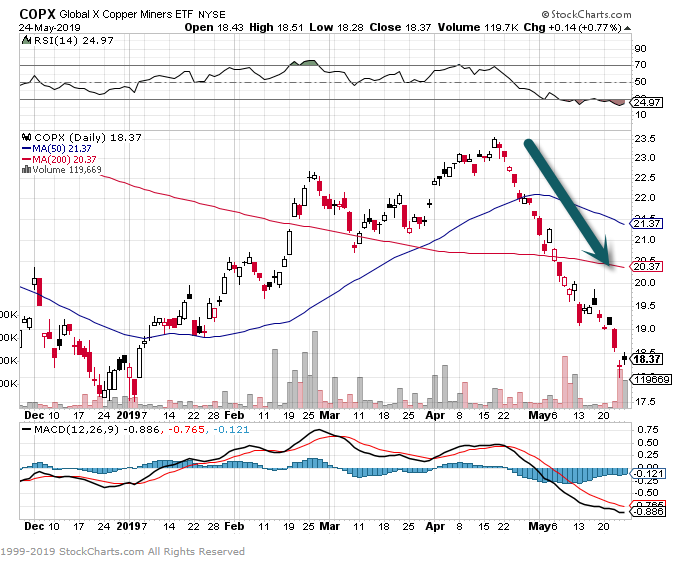
8.Driverless Cars Working Together Can Speed Up Traffic By 35%
TECHNOLOGY
WRITTEN BY: SARAVANA
MAY 20, 2019
For autonomous cars to be safely used on real roads, we need to know how they will interact with each other–Amanda Prorok
According to a research from University of Cambridge , a fleet of driverless cars working together to keep traffic moving smoothly can improve overall traffic flow by at least 35 percent, researchers from University of Cambridge have shown.
The researchers, programmed a small fleet of miniature robotic cars to drive on a multi-lane track and observed how the traffic flow changed when one of the cars stopped.
When the cars were not driving cooperatively, any cars behind the stopped car had to stop or slow down and wait for a gap in the traffic, as would typically happen on a real road. A queue quickly formed behind the stopped car and overall traffic flow was slowed.
However, when the cars were communicating with each other and driving cooperatively, as soon as one car stopped in the inner lane, it sent a signal to all the other cars. Cars in the outer lane that were in immediate proximity of the stopped car slowed down slightly so that cars in the inner lane were able to quickly pass the stopped car without having to stop or slow down significantly.
Additionally, when a human-controlled driver was put on the ‘road’ with the autonomous cars and moved around the track in an aggressive manner, the other cars were able to give way to avoid the aggressive driver, improving safety.
The results, to be presented today at the International Conference on Robotics and Automation (ICRA) in Montréal, will be useful for studying how autonomous cars can communicate with each other, and with cars controlled by human drivers, on real roads in the future.
“Autonomous cars could fix a lot of different problems associated with driving in cities, but there needs to be a way for them to work together,” said co-author Michael He, an undergraduate student at St John’s College, who designed the algorithms for the experiment.
“If different automotive manufacturers are all developing their own autonomous cars with their own software, those cars all need to communicate with each other effectively,” said co-author Nicholas Hyldmar, an undergraduate student at Downing College, who designed much of the hardware for the experiment.
The two students completed the work as part of an undergraduate research project in summer 2018, in the lab of Dr Amanda Prorok from Cambridge’s Department of Computer Science and Technology.
Many existing tests for multiple autonomous driverless cars are done digitally, or with scale models that are either too large or too expensive to carry out indoor experiments with fleets of cars.
Starting with inexpensive scale models of commercially-available vehicles with realistic steering systems, the Cambridge researchers adapted the cars with motion capture sensors and a Raspberry Pi, so that the cars could communicate via wifi.
They then adapted a lane-changing algorithm for autonomous cars to work with a fleet of cars. The original algorithm decides when a car should change lanes, based on whether it is safe to do so and whether changing lanes would help the car move through traffic more quickly. The adapted algorithm allows for cars to be packed more closely when changing lanes and adds a safety constraint to prevent crashes when speeds are low. A second algorithm allowed the cars to detect a projected car in front of it and make space.
They then tested the fleet in ‘egocentric’ and ‘cooperative’ driving modes, using both normal and aggressive driving behaviours, and observed how the fleet reacted to a stopped car. In the normal mode, cooperative driving improved traffic flow by 35% over egocentric driving, while for aggressive driving, the improvement was 45%. The researchers then tested how the fleet reacted to a single car controlled by a human via a joystick.
“Our design allows for a wide range of practical, low-cost experiments to be carried out on autonomous cars,” said Prorok. “For autonomous cars to be safely used on real roads, we need to know how they will interact with each other to improve safety and traffic flow.”
In future work, the researchers plan to use the fleet to test multi-car systems in more complex scenarios including roads with more lanes, intersections and a wider range of vehicle types.
https://gimtae.com/driverless-cars-working-together-can-speed-up-traffic-by-35/
Found at Bespoke https://www.bespokepremium.com/interactive/posts/think-big-blog/bespoke-brunch-reads-5-26-19
9.Brett Favre’s Concussion Start-UP
Brett Favre Wants to Keep Concussions From Benching Players Forever
| Brett Favre became a household name for football families like mine thanks to a storied two-decade, 71,838-passing-yard NFL career. But now, Favre has a new play earning him headlines.
He’s invested in a drug company called Prevacus. The startup is getting close to a treatment for concussions, an injury that’s concerned players, coaches, and parents at all levels of football (FYI, they make up 7.4% of all injuries in college football players). I spoke with Favre and Prevacus founder Dr. Jacob VanLandingham about their shared vision for a future without the negative impacts of concussions. So what is it? In lab tests, Prevacus (which has been approved for FDA fast track status) has reduced brain inflammation and swelling. If it works on humans, the treatment could lessen the chances someone with a concussion develops CTE, aka chronic traumatic encephalopathy aka a cause of devastating problems like depression, memory loss, and mood disorders. Let’s talk money. Since its start in my hometown of Tallahassee, FL, a little over five years ago, Prevacus has raised roughly $10 million.
Sidenote: Favre’s joined on the Prevacus-backer roster by Kurt Warner, Abby Wambach, and David “Grandpa Rossy” Ross, to name a few. Why is there a need? A 2017 paper in the Journal of the American Medical Association found that, among 111 brains from former NFL players donated to a project to study the long-term effects of repeated head trauma, 110 had CTE. Some faulted that report’s selection bias and small sample size, but a follow-up study found that at least 9.6% of NFL players who died from 2008-2016 had CTE. The impacts are, quite literally, life threatening. Per Favre, “You see former players with anything from either killing themselves or they can’t remember anything or get Lou Gehrig’s disease…as a result of concussions.”
So we’re starting to see innovation Thanks to rule changes and advances in helmet tech, the number of diagnosed concussions in the NFL dropped 24% in preseason and regular season games last year. Even still, Favre believes concussions “are going to happen”…which is part of why he’d “much rather” his three grandsons play golf (they’re coming for you, Koepka). It’s also why, while some ex-players home in on preventative measures, Favre is focused on treatment.
So what’s next for Prevacus? Favre and VanLandingham hope to start human trials this summer. If all goes to plan, they’ll begin selling to certain populations after Thanksgiving. |
10.5 Signs You Need to Develop Your Leadership Skills.
We all look for signs that give us an indication that we’re doing the right things. Children look to their parents for praise when they’ve done something well. Students anxiously await final grades to see if the work they put in added up. However, when it comes to leadership and knowing exactly how you are doing in the workplace, the signs tend to be less noticeable.
For the first year leading a team, I thought I was doing a great job. It wasn’t until I lost a high performing team member unexpectedly did I learn my perception wasn’t reality. If only I had been looking for some of these less obvious signs.
- There’s High Voluntary Turnover
Today’s talent pool has never been shallower. According to the US Department of Labor, the unemployment rate in the US is at a staggeringly low number of 3.6 percent. While there are many positives to the current economic market, having a team member leave voluntarily hurts more than ever before. Finding their replacement has become an increasingly challenging and costly task.
While there are many factors for turnover, the most impactful is the relationship between managers and direct reports. Instead of chalking up the loss of an employee to “the market,” it’s time to look in the mirror and evaluate whether you are the root cause.
- Talented Professionals are Stagnating in their Current Roles
I’ve heard popular theories stating that professionals should change jobs every three years. Whether the argument is valid or not, there is no doubt that talented professionals should be growing their skills and getting better. Where they achieve that growth is the real question.
The best leaders encourage and look for ways to help their people grow and succeed. Instead of hoarding talent, they promote and challenge people to reach higher levels of performance. While not every organization has the ability to promote these people, there are still ways you can stave off stagnation.
If you have people who have become stagnant and stay in roles where they are no longer growing, consider what you can do to continue their professional growth. Can they mentor someone else? Can they expand their skills in their current role? What other business vertical might they be interested in learning about?
- No One is Taking Risks
Innovation and big payoffs rarely come without someone taking risks. If people on your team aren’t taking risks, there is a good chance your team culture is one that promotes a fear of failure. With my coaching clients, this thinking is promoted by the manager.
Failure is only final if you give up. The best leaders not only promote the idea of taking risks, but they encourage their team to look for better and more innovative ways of doing things.
- No One Asks for Help
Silence is a dangerous sound. If people stop asking for your help or your opinion, there is a good chance they don’t trust or value your words. This happens for one of two reasons– either they don’t think you will/can help them or you don’t actively coach them.
If silence is a problem, coaching is one solution. Instead of being reactive or unresponsive, play the role of coach for your people. The best coaches, as highlighted in one of my favorite books The Trillion Dollar Coach, “coach in the moment.” They don’t let time pass without giving constructive feedback and asking pertinent questions to get to the heart of the problem.
- Team Members Effort Resembles a King Charles Cavalier
A mentor of mine told me, “John, what you tolerate as a leader, you encourage.” I believe he is right. Lack of effort from team members is one of the most prominent area’s leaders tolerate, thus encourage.
Does the daily effort of your team resemble that of my eight-year-old King Charles Cavalier? (Note: His inactivity has required numerous pulse checks. If so, there is a good chance you have encouraged this lack of effort in some way shape or form.)
Instead of discouraging lack of effort, bring energy to your team. Find a way to get them excited about what they’re doing every day. We do this on my team and in our Building the Best Workshop, by implementing a Maximizing Mantra. This is a short rally cry that energizes and unites groups. Whether they are down on a loss or high on a win, a Maximizing Mantra creates an energy that drives effort.
If you find that one or more of these signs are present on your team, the great news is you have the opportunity to turn it around. Just because your team needs a better leader doesn’t mean it has to be someone else. You can grow, and you can get better.
Failure is not final as long as you don’t stop and give up. Use your failure as feedback.
What’s Your Leadership Style? Join over 40k leaders and discover how well you are leveraging love and discipline as a leader and find out your current leadership style for free.
Leadership Workshop: Want to improve the performance of your team or business? Want to elevate the way you lead? Join me on June 25th in Charlotte, NC, for a Building the Best workshop. Learn more here.
About the Author: John Eades is the CEO of LearnLoft, a leadership development company which exists to turn managers into leaders and create healthier places to work. John was named one of LinkedIn’s 2017 Top Voices in Management & Workplace and was awarded the 2017 Readership Award by Training Industry.com. John is also the author the upcoming book Building the Best: 8 Proven Leadership Principles to Elevate Others to Success and host of the “Follow My Lead” Podcast, a show that transfers stories and best practices from today’s leaders to the leaders of tomorrow. You follow him on Instagram @johngeades.
https://www.bbntimes.com/en/companies/5-signs-it-s-time-to-develop-your-leadership-skills
